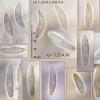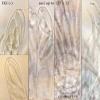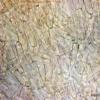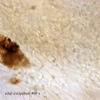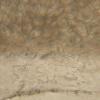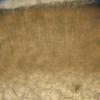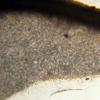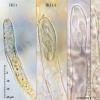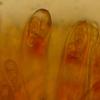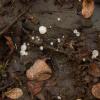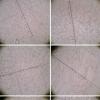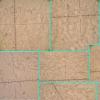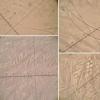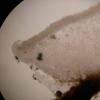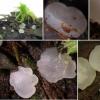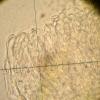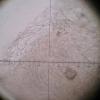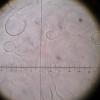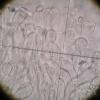
24-12-2025 17:08
Hulda Caroline HolteHello, I have found this propoloid ascomycete on

21-12-2025 09:32
Hello.A tiny ascomycete found embedded in wood in

21-12-2025 21:32
Pol DebaenstHello, Garden, Burgweg 19, Veurne, BelgiumOn 10/1

22-12-2025 23:38
Patrice TANCHAUDBonsoir, récolte sur un mur en pierre, apothéci

22-12-2025 00:47
Patrice TANCHAUDBonsoir, récolte à proximité du milieu dunaire
Yesterday we have seen this lenticular to pulvinate totally whitish ascomata up to 5-6 mm in diam. that grows on Eriophorum angustifolium old leaves (and ericaceous host too) on very wet acid soil.
The ascomata are sessile on a very broad base and they are glabrous.
The medullary excipulum has a loose textura intricata without crystals that becomes very gelified at the cortex. I think the asci are IKI negative (or very faintly positive?). Croziers positive. The spores have a faintly gel sheath around them.
I think is not an Hymenoscyphus species but I don't know a good genus for it
What's your opinion?
Best, Uwe

No idea.
Zotto
I will wait to my next life for to know his name

I have considered this possibility but I don't know well this genus and in García & Van Vooren's keys i don't see 'my fungus'
Enrique

The distribution of gel would quite well fit Pezoloma, yes. And the occurrence in a bog with Ericaceae also.
A quite distinct t. prismatica or t. globulosa is seen in section of P. marchantiae and P. ciliifera. This +/- thick layer delimits the outer gel layer and the inner t. intricata. I completely miss such a layer in Enrique's specimen.
Zotto
I have seen any textura prismatica or globulosa in the excipulum, that is made of cylindrical or slightly inflated elements
Enrique

That these inflated cells are not really globulose but mainly also elongate and intricata-like is seen on the attached images. of P. ciliifera. So i think there is no strong difference to your species, and the genus Pezoloma quite probable.
Zotto
By the other hand I have seen inmature ascus IKI red in Pezoloma ciliifera as you show in HB-3074. Mature asci seems to have ascus IKI negative?
J'ai plusieurs récoltes d'un champignon sans nom (publication en attente avec Zotto) qui me semble proche si ne n'est semblable au tien, mais avec une taille de spores plus courte. En voici la description et une photo macro.
Qu'en penses-tu ?
GG06073002, GG06081303
Le 30-07-2006, Fraisse-sur-Agout, Col de La Bane, saulaie
tourbo-fangeuse en bord de ruisseau (après les méandres). Sur feuilles, débris
herbacés et algues collés à la terre dans une cuvette exondée.
Plusieurs apothécies, entièrement blanches, sessiles, à
marge concolore à peine différenciée au début (un peu enroulée), hyménium plat
puis un peu bombé. Diamètre 2 à 5 mm, de forme circulaire ou plus ou moins
déformé. Généralement en troupe de 4-5 spécimens mais isolés.
Flancs et marge finement villeux sous la bino.
Paraphyses nombreuses, droites, régulièrement linéaires,
1,5-2 µm de diamètre, à sommet non élargi et arrondi, multiseptées, sans
guttules réfringeantes, non exertes, formant un épithécium et ramifiées à la
base.
Asques cylindriques, rarement légèrement clavés dans la
partie haute, octospores (rarement tétraspores), IKI et Melzer négatifs,
pleurorynches (mais pas évident sur certains asques), 70-100 x 8-10-12 µm. Pars
sporifera 35-40 µm.
Sous-hyménium de textura angularis sur 3-4 rangées de
cellules superposées prismatiques.
Spores hyalines, lisses, non cloisonnées dans l'asque
(parfois un septum médian en fin de maturité hors de l'asque), contenu huileux
3-4(5), elliptiques, un peu courbées sur une face, avec un sommet légèrement apointi,
12-17 x 4-5 µm.
Poils courts, à sommet clavé
terminant un empilement de plusieurs petites cellules angulo-prismatiques.
Chair à tendance epidermoidea
constituée de cellules, parfois assez grandes, en forme de grosse saucisse. A
la base de l'apothécie, de fines hyphes cylindriques de texture intricata, à
peine gélifiées, adhèrent aux algues ou autres débris herbacés. Aucune réaction
au réactif de Melzer.
Pas de cristaux.
Commentaires : Me semble proche du genre Pezoloma !
Retrouvé au même emplacement le 05-08-2007, une dizaine
d'exemplaires. Sur cette récolte, les asques arrivent jusqu'à 125 µm de long et
l'insensibilité aux réactifs iodés est confirmée même après un passage à la
potasse. Récolte conservée sous GG07080503. Photos macro et micro.

could well be the same. Looking forward for seeing microphotos
Zotto
Can you send us your microphotos?
Enrique

I suppose that the margin is characteristic, protruding, rather thick, of wide clavate cortical elelements.
And yes, I now realize that HB 5579 is probably the same fungus.
Zotto


